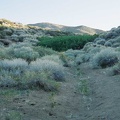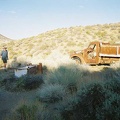Close-up of the giant wild roses at Goldbelt Spring
When I get close up, I realize that the roses are even taller than I thought, a bit taller than me. Presuming that the roses are growing on top of Goldbelt Spring, some water should be coming out from under the roses right where I'm standing--when the spring is flowing.
Indeed, there is cold, moist air exuding from the rose patch, so there might be some surface water in there somewhere.
I walk around the rose thicket to see if any water is visible, but none is. The thicket is a thorny, impenetrable mass, so there's no way to get into the middle of it to see what's in there.
There are lots of dried rose hips on the plants, which are probably last year's harvest. I'm surprised that the birds haven't eaten them all yet.
I eat a couple, discarding the inner seeds, which leaves little more than the thin outer skin. They're quite flavourful in a tart-sweet way that reminds me of dried apricots.

